Analysis of Mental Wellbeing, Self-Efficacy, and Gender: ANOVA Report
VerifiedAdded on 2020/04/13
|6
|2037
|285
Report
AI Summary
This report presents the findings of a two-way fixed ANOVA model investigating the relationship between mental wellbeing, self-efficacy, and gender among 114 participants. The analysis revealed that the interaction effect between gender and self-efficacy was statistically insignificant, leading to the removal of the interaction term from the model. Self-efficacy was found to be a significant predictor of mental wellbeing, while gender was not. The study also discussed the limitations, including the use of a non-probability sampling method and gender representation issues, impacting the generalizability of the results. The study concluded that the two-way ANOVA model can be used to determine the level of mental wellness and self-efficacy can predict 13.3% of the variation in mental wellbeing in the sample.
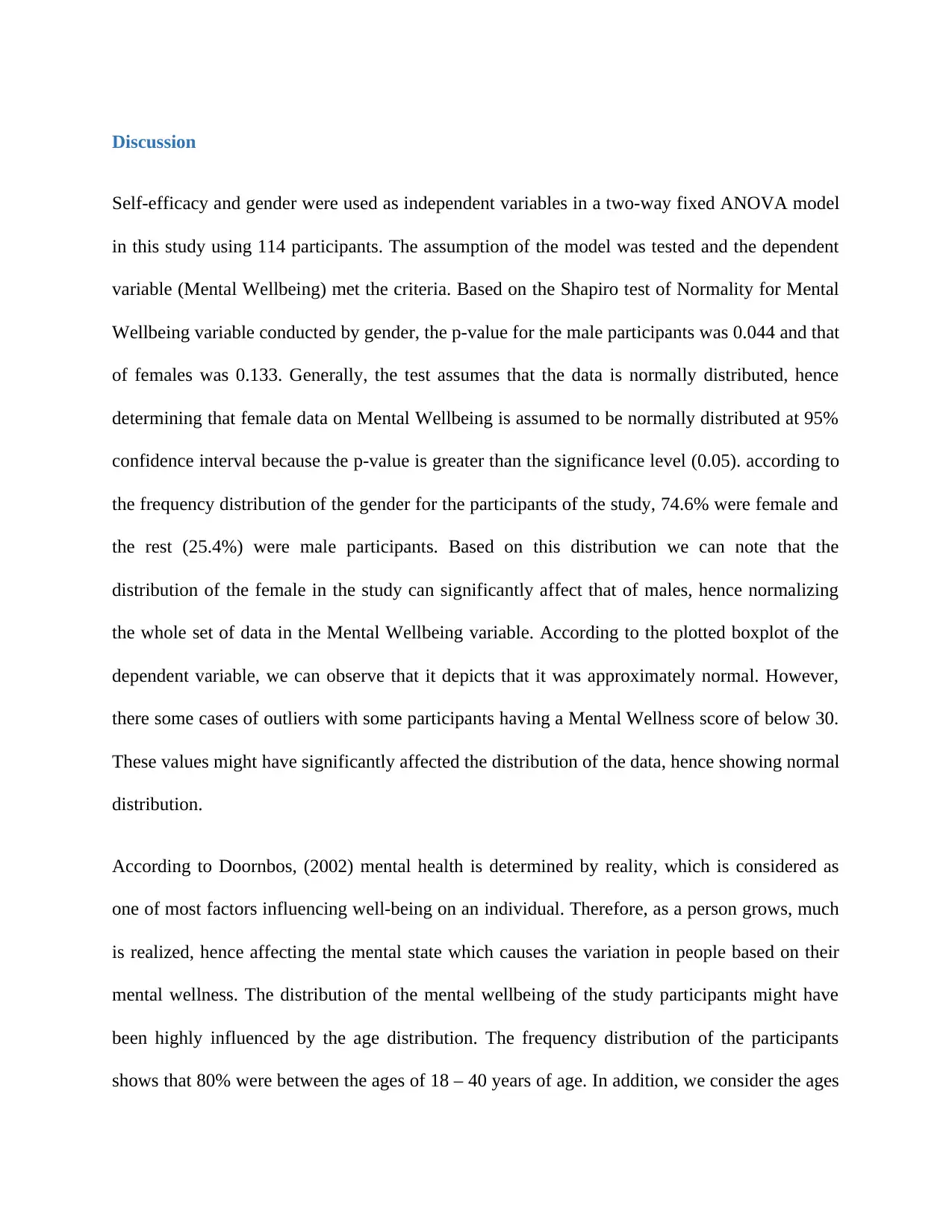
Discussion
Self-efficacy and gender were used as independent variables in a two-way fixed ANOVA model
in this study using 114 participants. The assumption of the model was tested and the dependent
variable (Mental Wellbeing) met the criteria. Based on the Shapiro test of Normality for Mental
Wellbeing variable conducted by gender, the p-value for the male participants was 0.044 and that
of females was 0.133. Generally, the test assumes that the data is normally distributed, hence
determining that female data on Mental Wellbeing is assumed to be normally distributed at 95%
confidence interval because the p-value is greater than the significance level (0.05). according to
the frequency distribution of the gender for the participants of the study, 74.6% were female and
the rest (25.4%) were male participants. Based on this distribution we can note that the
distribution of the female in the study can significantly affect that of males, hence normalizing
the whole set of data in the Mental Wellbeing variable. According to the plotted boxplot of the
dependent variable, we can observe that it depicts that it was approximately normal. However,
there some cases of outliers with some participants having a Mental Wellness score of below 30.
These values might have significantly affected the distribution of the data, hence showing normal
distribution.
According to Doornbos, (2002) mental health is determined by reality, which is considered as
one of most factors influencing well-being on an individual. Therefore, as a person grows, much
is realized, hence affecting the mental state which causes the variation in people based on their
mental wellness. The distribution of the mental wellbeing of the study participants might have
been highly influenced by the age distribution. The frequency distribution of the participants
shows that 80% were between the ages of 18 – 40 years of age. In addition, we consider the ages
Self-efficacy and gender were used as independent variables in a two-way fixed ANOVA model
in this study using 114 participants. The assumption of the model was tested and the dependent
variable (Mental Wellbeing) met the criteria. Based on the Shapiro test of Normality for Mental
Wellbeing variable conducted by gender, the p-value for the male participants was 0.044 and that
of females was 0.133. Generally, the test assumes that the data is normally distributed, hence
determining that female data on Mental Wellbeing is assumed to be normally distributed at 95%
confidence interval because the p-value is greater than the significance level (0.05). according to
the frequency distribution of the gender for the participants of the study, 74.6% were female and
the rest (25.4%) were male participants. Based on this distribution we can note that the
distribution of the female in the study can significantly affect that of males, hence normalizing
the whole set of data in the Mental Wellbeing variable. According to the plotted boxplot of the
dependent variable, we can observe that it depicts that it was approximately normal. However,
there some cases of outliers with some participants having a Mental Wellness score of below 30.
These values might have significantly affected the distribution of the data, hence showing normal
distribution.
According to Doornbos, (2002) mental health is determined by reality, which is considered as
one of most factors influencing well-being on an individual. Therefore, as a person grows, much
is realized, hence affecting the mental state which causes the variation in people based on their
mental wellness. The distribution of the mental wellbeing of the study participants might have
been highly influenced by the age distribution. The frequency distribution of the participants
shows that 80% were between the ages of 18 – 40 years of age. In addition, we consider the ages
Paraphrase This Document
Need a fresh take? Get an instant paraphrase of this document with our AI Paraphraser
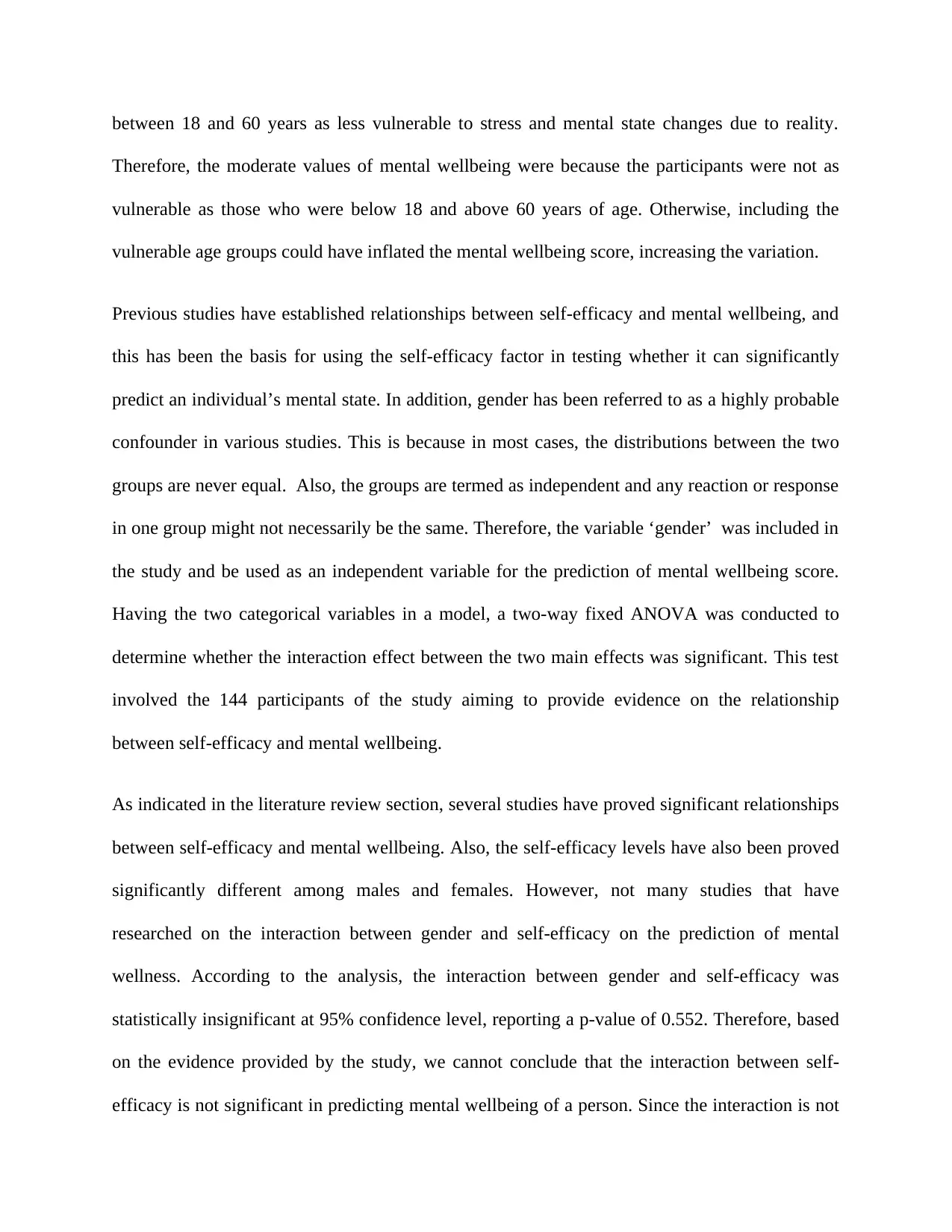
between 18 and 60 years as less vulnerable to stress and mental state changes due to reality.
Therefore, the moderate values of mental wellbeing were because the participants were not as
vulnerable as those who were below 18 and above 60 years of age. Otherwise, including the
vulnerable age groups could have inflated the mental wellbeing score, increasing the variation.
Previous studies have established relationships between self-efficacy and mental wellbeing, and
this has been the basis for using the self-efficacy factor in testing whether it can significantly
predict an individual’s mental state. In addition, gender has been referred to as a highly probable
confounder in various studies. This is because in most cases, the distributions between the two
groups are never equal. Also, the groups are termed as independent and any reaction or response
in one group might not necessarily be the same. Therefore, the variable ‘gender’ was included in
the study and be used as an independent variable for the prediction of mental wellbeing score.
Having the two categorical variables in a model, a two-way fixed ANOVA was conducted to
determine whether the interaction effect between the two main effects was significant. This test
involved the 144 participants of the study aiming to provide evidence on the relationship
between self-efficacy and mental wellbeing.
As indicated in the literature review section, several studies have proved significant relationships
between self-efficacy and mental wellbeing. Also, the self-efficacy levels have also been proved
significantly different among males and females. However, not many studies that have
researched on the interaction between gender and self-efficacy on the prediction of mental
wellness. According to the analysis, the interaction between gender and self-efficacy was
statistically insignificant at 95% confidence level, reporting a p-value of 0.552. Therefore, based
on the evidence provided by the study, we cannot conclude that the interaction between self-
efficacy is not significant in predicting mental wellbeing of a person. Since the interaction is not
Therefore, the moderate values of mental wellbeing were because the participants were not as
vulnerable as those who were below 18 and above 60 years of age. Otherwise, including the
vulnerable age groups could have inflated the mental wellbeing score, increasing the variation.
Previous studies have established relationships between self-efficacy and mental wellbeing, and
this has been the basis for using the self-efficacy factor in testing whether it can significantly
predict an individual’s mental state. In addition, gender has been referred to as a highly probable
confounder in various studies. This is because in most cases, the distributions between the two
groups are never equal. Also, the groups are termed as independent and any reaction or response
in one group might not necessarily be the same. Therefore, the variable ‘gender’ was included in
the study and be used as an independent variable for the prediction of mental wellbeing score.
Having the two categorical variables in a model, a two-way fixed ANOVA was conducted to
determine whether the interaction effect between the two main effects was significant. This test
involved the 144 participants of the study aiming to provide evidence on the relationship
between self-efficacy and mental wellbeing.
As indicated in the literature review section, several studies have proved significant relationships
between self-efficacy and mental wellbeing. Also, the self-efficacy levels have also been proved
significantly different among males and females. However, not many studies that have
researched on the interaction between gender and self-efficacy on the prediction of mental
wellness. According to the analysis, the interaction between gender and self-efficacy was
statistically insignificant at 95% confidence level, reporting a p-value of 0.552. Therefore, based
on the evidence provided by the study, we cannot conclude that the interaction between self-
efficacy is not significant in predicting mental wellbeing of a person. Since the interaction is not
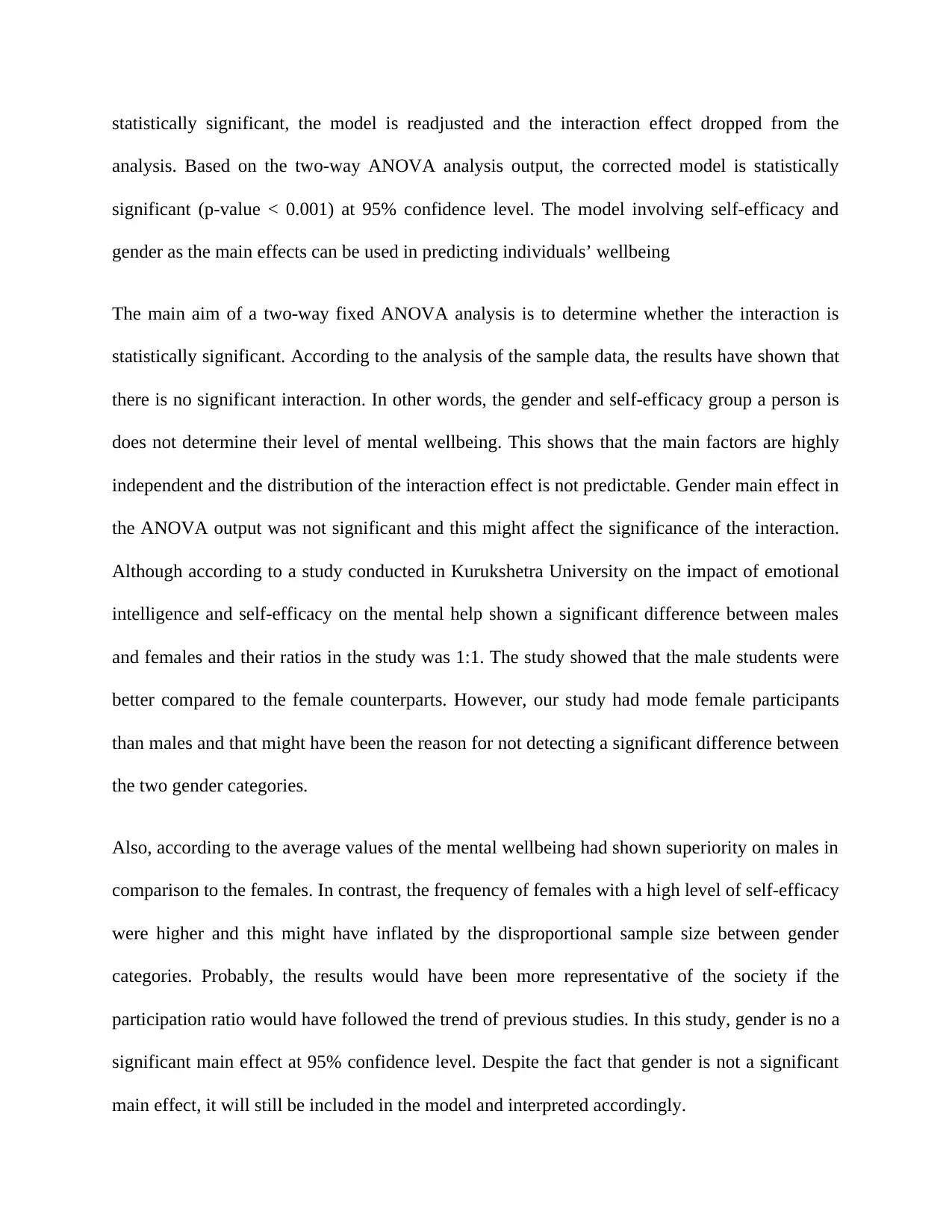
statistically significant, the model is readjusted and the interaction effect dropped from the
analysis. Based on the two-way ANOVA analysis output, the corrected model is statistically
significant (p-value < 0.001) at 95% confidence level. The model involving self-efficacy and
gender as the main effects can be used in predicting individuals’ wellbeing
The main aim of a two-way fixed ANOVA analysis is to determine whether the interaction is
statistically significant. According to the analysis of the sample data, the results have shown that
there is no significant interaction. In other words, the gender and self-efficacy group a person is
does not determine their level of mental wellbeing. This shows that the main factors are highly
independent and the distribution of the interaction effect is not predictable. Gender main effect in
the ANOVA output was not significant and this might affect the significance of the interaction.
Although according to a study conducted in Kurukshetra University on the impact of emotional
intelligence and self-efficacy on the mental help shown a significant difference between males
and females and their ratios in the study was 1:1. The study showed that the male students were
better compared to the female counterparts. However, our study had mode female participants
than males and that might have been the reason for not detecting a significant difference between
the two gender categories.
Also, according to the average values of the mental wellbeing had shown superiority on males in
comparison to the females. In contrast, the frequency of females with a high level of self-efficacy
were higher and this might have inflated by the disproportional sample size between gender
categories. Probably, the results would have been more representative of the society if the
participation ratio would have followed the trend of previous studies. In this study, gender is no a
significant main effect at 95% confidence level. Despite the fact that gender is not a significant
main effect, it will still be included in the model and interpreted accordingly.
analysis. Based on the two-way ANOVA analysis output, the corrected model is statistically
significant (p-value < 0.001) at 95% confidence level. The model involving self-efficacy and
gender as the main effects can be used in predicting individuals’ wellbeing
The main aim of a two-way fixed ANOVA analysis is to determine whether the interaction is
statistically significant. According to the analysis of the sample data, the results have shown that
there is no significant interaction. In other words, the gender and self-efficacy group a person is
does not determine their level of mental wellbeing. This shows that the main factors are highly
independent and the distribution of the interaction effect is not predictable. Gender main effect in
the ANOVA output was not significant and this might affect the significance of the interaction.
Although according to a study conducted in Kurukshetra University on the impact of emotional
intelligence and self-efficacy on the mental help shown a significant difference between males
and females and their ratios in the study was 1:1. The study showed that the male students were
better compared to the female counterparts. However, our study had mode female participants
than males and that might have been the reason for not detecting a significant difference between
the two gender categories.
Also, according to the average values of the mental wellbeing had shown superiority on males in
comparison to the females. In contrast, the frequency of females with a high level of self-efficacy
were higher and this might have inflated by the disproportional sample size between gender
categories. Probably, the results would have been more representative of the society if the
participation ratio would have followed the trend of previous studies. In this study, gender is no a
significant main effect at 95% confidence level. Despite the fact that gender is not a significant
main effect, it will still be included in the model and interpreted accordingly.
⊘ This is a preview!⊘
Do you want full access?
Subscribe today to unlock all pages.

Trusted by 1+ million students worldwide
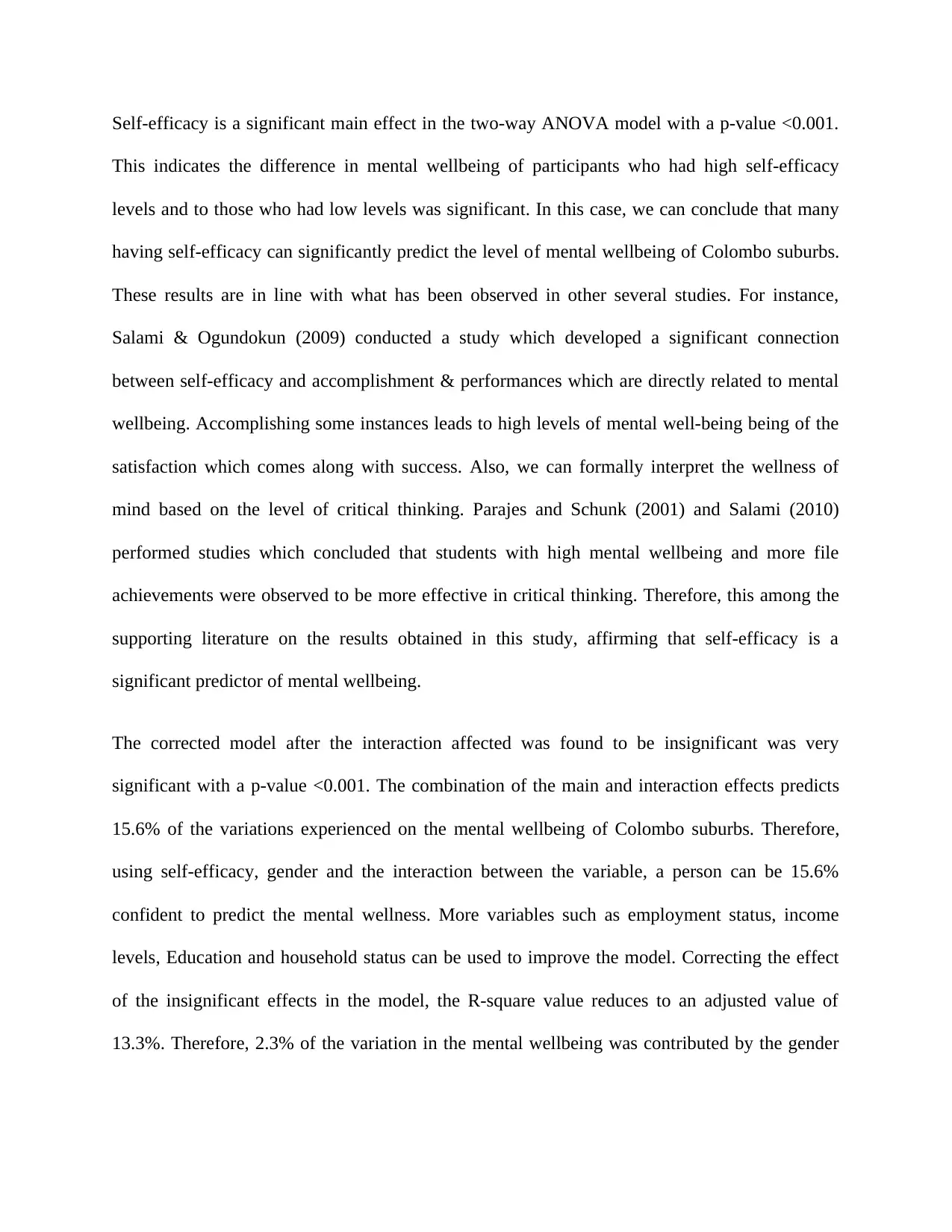
Self-efficacy is a significant main effect in the two-way ANOVA model with a p-value <0.001.
This indicates the difference in mental wellbeing of participants who had high self-efficacy
levels and to those who had low levels was significant. In this case, we can conclude that many
having self-efficacy can significantly predict the level of mental wellbeing of Colombo suburbs.
These results are in line with what has been observed in other several studies. For instance,
Salami & Ogundokun (2009) conducted a study which developed a significant connection
between self-efficacy and accomplishment & performances which are directly related to mental
wellbeing. Accomplishing some instances leads to high levels of mental well-being being of the
satisfaction which comes along with success. Also, we can formally interpret the wellness of
mind based on the level of critical thinking. Parajes and Schunk (2001) and Salami (2010)
performed studies which concluded that students with high mental wellbeing and more file
achievements were observed to be more effective in critical thinking. Therefore, this among the
supporting literature on the results obtained in this study, affirming that self-efficacy is a
significant predictor of mental wellbeing.
The corrected model after the interaction affected was found to be insignificant was very
significant with a p-value <0.001. The combination of the main and interaction effects predicts
15.6% of the variations experienced on the mental wellbeing of Colombo suburbs. Therefore,
using self-efficacy, gender and the interaction between the variable, a person can be 15.6%
confident to predict the mental wellness. More variables such as employment status, income
levels, Education and household status can be used to improve the model. Correcting the effect
of the insignificant effects in the model, the R-square value reduces to an adjusted value of
13.3%. Therefore, 2.3% of the variation in the mental wellbeing was contributed by the gender
This indicates the difference in mental wellbeing of participants who had high self-efficacy
levels and to those who had low levels was significant. In this case, we can conclude that many
having self-efficacy can significantly predict the level of mental wellbeing of Colombo suburbs.
These results are in line with what has been observed in other several studies. For instance,
Salami & Ogundokun (2009) conducted a study which developed a significant connection
between self-efficacy and accomplishment & performances which are directly related to mental
wellbeing. Accomplishing some instances leads to high levels of mental well-being being of the
satisfaction which comes along with success. Also, we can formally interpret the wellness of
mind based on the level of critical thinking. Parajes and Schunk (2001) and Salami (2010)
performed studies which concluded that students with high mental wellbeing and more file
achievements were observed to be more effective in critical thinking. Therefore, this among the
supporting literature on the results obtained in this study, affirming that self-efficacy is a
significant predictor of mental wellbeing.
The corrected model after the interaction affected was found to be insignificant was very
significant with a p-value <0.001. The combination of the main and interaction effects predicts
15.6% of the variations experienced on the mental wellbeing of Colombo suburbs. Therefore,
using self-efficacy, gender and the interaction between the variable, a person can be 15.6%
confident to predict the mental wellness. More variables such as employment status, income
levels, Education and household status can be used to improve the model. Correcting the effect
of the insignificant effects in the model, the R-square value reduces to an adjusted value of
13.3%. Therefore, 2.3% of the variation in the mental wellbeing was contributed by the gender
Paraphrase This Document
Need a fresh take? Get an instant paraphrase of this document with our AI Paraphraser
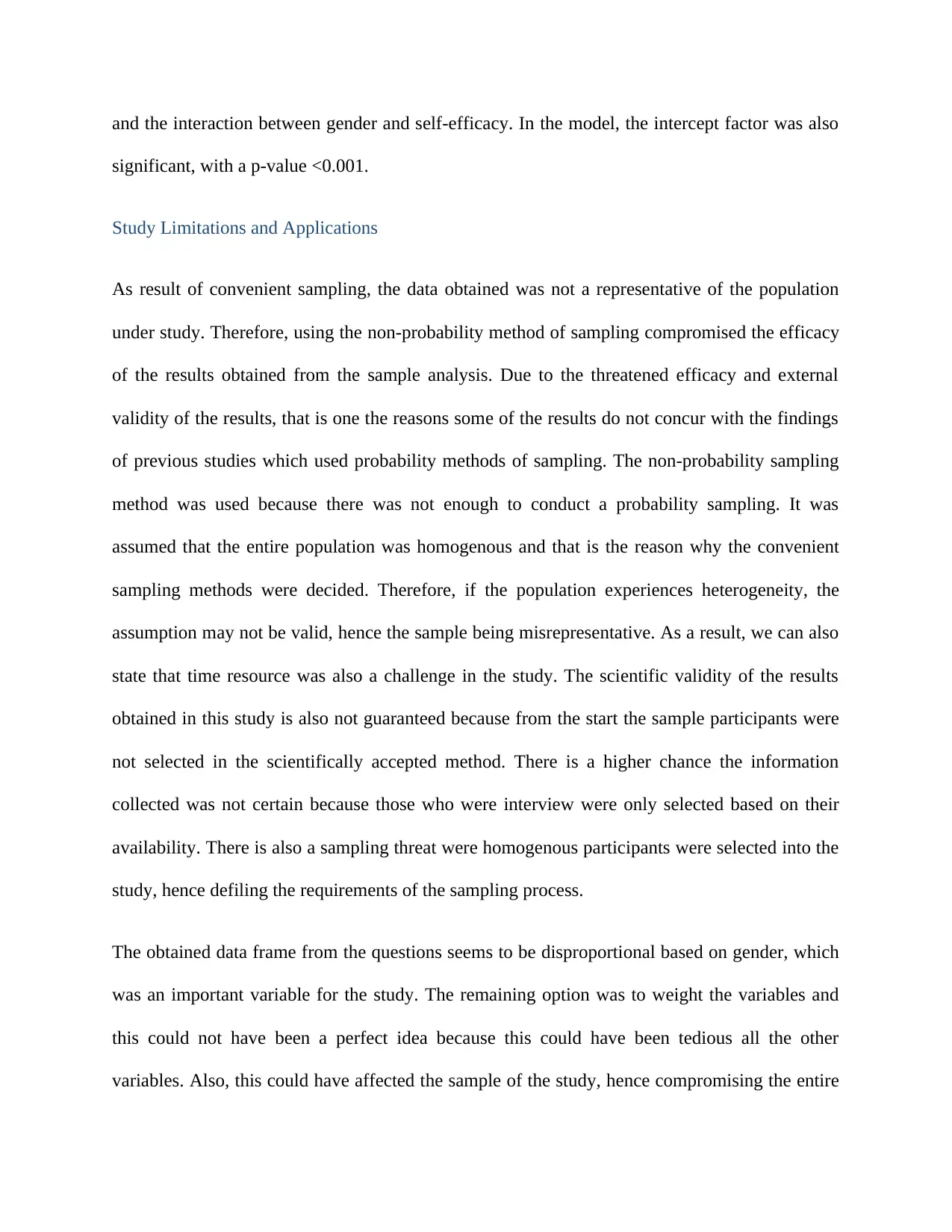
and the interaction between gender and self-efficacy. In the model, the intercept factor was also
significant, with a p-value <0.001.
Study Limitations and Applications
As result of convenient sampling, the data obtained was not a representative of the population
under study. Therefore, using the non-probability method of sampling compromised the efficacy
of the results obtained from the sample analysis. Due to the threatened efficacy and external
validity of the results, that is one the reasons some of the results do not concur with the findings
of previous studies which used probability methods of sampling. The non-probability sampling
method was used because there was not enough to conduct a probability sampling. It was
assumed that the entire population was homogenous and that is the reason why the convenient
sampling methods were decided. Therefore, if the population experiences heterogeneity, the
assumption may not be valid, hence the sample being misrepresentative. As a result, we can also
state that time resource was also a challenge in the study. The scientific validity of the results
obtained in this study is also not guaranteed because from the start the sample participants were
not selected in the scientifically accepted method. There is a higher chance the information
collected was not certain because those who were interview were only selected based on their
availability. There is also a sampling threat were homogenous participants were selected into the
study, hence defiling the requirements of the sampling process.
The obtained data frame from the questions seems to be disproportional based on gender, which
was an important variable for the study. The remaining option was to weight the variables and
this could not have been a perfect idea because this could have been tedious all the other
variables. Also, this could have affected the sample of the study, hence compromising the entire
significant, with a p-value <0.001.
Study Limitations and Applications
As result of convenient sampling, the data obtained was not a representative of the population
under study. Therefore, using the non-probability method of sampling compromised the efficacy
of the results obtained from the sample analysis. Due to the threatened efficacy and external
validity of the results, that is one the reasons some of the results do not concur with the findings
of previous studies which used probability methods of sampling. The non-probability sampling
method was used because there was not enough to conduct a probability sampling. It was
assumed that the entire population was homogenous and that is the reason why the convenient
sampling methods were decided. Therefore, if the population experiences heterogeneity, the
assumption may not be valid, hence the sample being misrepresentative. As a result, we can also
state that time resource was also a challenge in the study. The scientific validity of the results
obtained in this study is also not guaranteed because from the start the sample participants were
not selected in the scientifically accepted method. There is a higher chance the information
collected was not certain because those who were interview were only selected based on their
availability. There is also a sampling threat were homogenous participants were selected into the
study, hence defiling the requirements of the sampling process.
The obtained data frame from the questions seems to be disproportional based on gender, which
was an important variable for the study. The remaining option was to weight the variables and
this could not have been a perfect idea because this could have been tedious all the other
variables. Also, this could have affected the sample of the study, hence compromising the entire
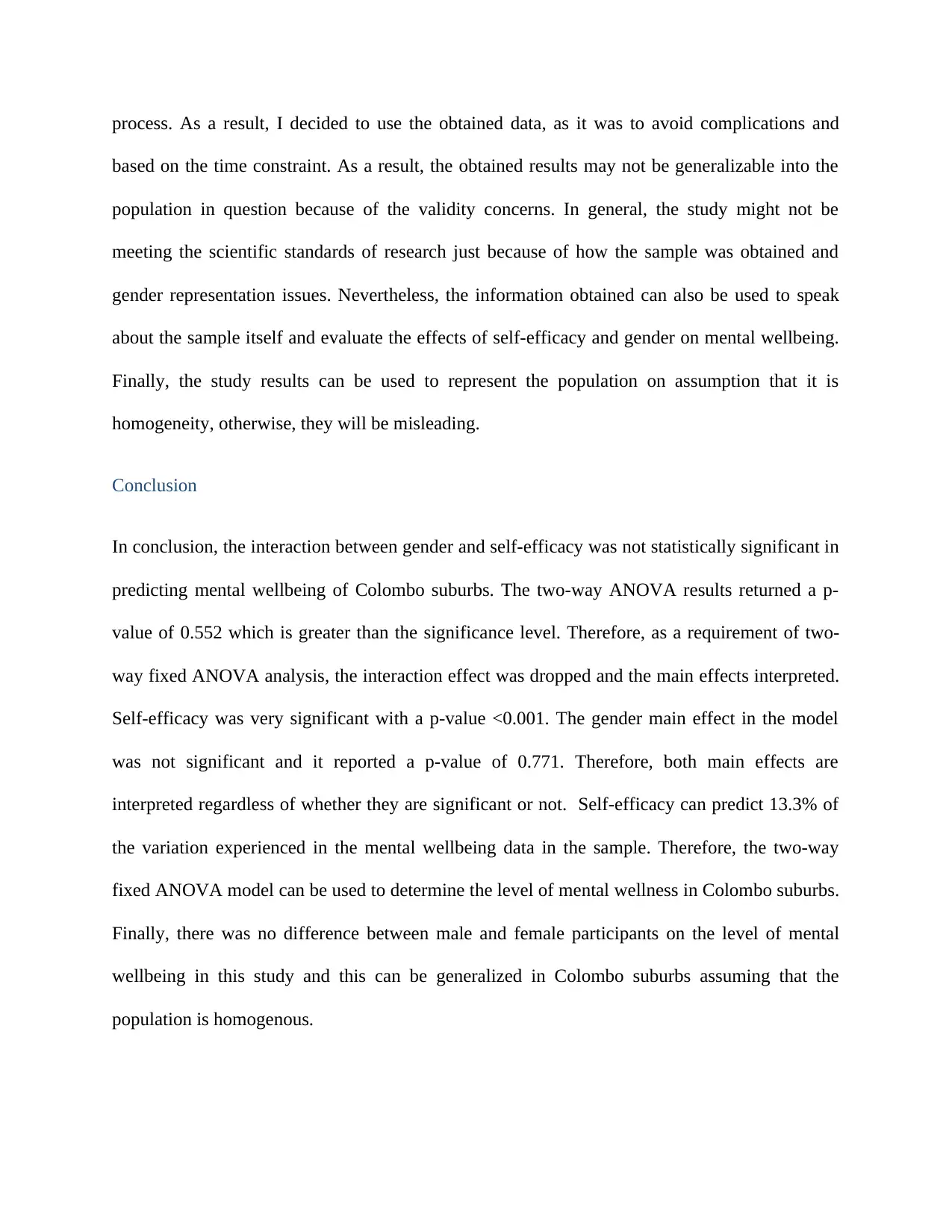
process. As a result, I decided to use the obtained data, as it was to avoid complications and
based on the time constraint. As a result, the obtained results may not be generalizable into the
population in question because of the validity concerns. In general, the study might not be
meeting the scientific standards of research just because of how the sample was obtained and
gender representation issues. Nevertheless, the information obtained can also be used to speak
about the sample itself and evaluate the effects of self-efficacy and gender on mental wellbeing.
Finally, the study results can be used to represent the population on assumption that it is
homogeneity, otherwise, they will be misleading.
Conclusion
In conclusion, the interaction between gender and self-efficacy was not statistically significant in
predicting mental wellbeing of Colombo suburbs. The two-way ANOVA results returned a p-
value of 0.552 which is greater than the significance level. Therefore, as a requirement of two-
way fixed ANOVA analysis, the interaction effect was dropped and the main effects interpreted.
Self-efficacy was very significant with a p-value <0.001. The gender main effect in the model
was not significant and it reported a p-value of 0.771. Therefore, both main effects are
interpreted regardless of whether they are significant or not. Self-efficacy can predict 13.3% of
the variation experienced in the mental wellbeing data in the sample. Therefore, the two-way
fixed ANOVA model can be used to determine the level of mental wellness in Colombo suburbs.
Finally, there was no difference between male and female participants on the level of mental
wellbeing in this study and this can be generalized in Colombo suburbs assuming that the
population is homogenous.
based on the time constraint. As a result, the obtained results may not be generalizable into the
population in question because of the validity concerns. In general, the study might not be
meeting the scientific standards of research just because of how the sample was obtained and
gender representation issues. Nevertheless, the information obtained can also be used to speak
about the sample itself and evaluate the effects of self-efficacy and gender on mental wellbeing.
Finally, the study results can be used to represent the population on assumption that it is
homogeneity, otherwise, they will be misleading.
Conclusion
In conclusion, the interaction between gender and self-efficacy was not statistically significant in
predicting mental wellbeing of Colombo suburbs. The two-way ANOVA results returned a p-
value of 0.552 which is greater than the significance level. Therefore, as a requirement of two-
way fixed ANOVA analysis, the interaction effect was dropped and the main effects interpreted.
Self-efficacy was very significant with a p-value <0.001. The gender main effect in the model
was not significant and it reported a p-value of 0.771. Therefore, both main effects are
interpreted regardless of whether they are significant or not. Self-efficacy can predict 13.3% of
the variation experienced in the mental wellbeing data in the sample. Therefore, the two-way
fixed ANOVA model can be used to determine the level of mental wellness in Colombo suburbs.
Finally, there was no difference between male and female participants on the level of mental
wellbeing in this study and this can be generalized in Colombo suburbs assuming that the
population is homogenous.
⊘ This is a preview!⊘
Do you want full access?
Subscribe today to unlock all pages.

Trusted by 1+ million students worldwide
1 out of 6
Related Documents
Your All-in-One AI-Powered Toolkit for Academic Success.
+13062052269
info@desklib.com
Available 24*7 on WhatsApp / Email
![[object Object]](/_next/static/media/star-bottom.7253800d.svg)
Unlock your academic potential
Copyright © 2020–2025 A2Z Services. All Rights Reserved. Developed and managed by ZUCOL.





